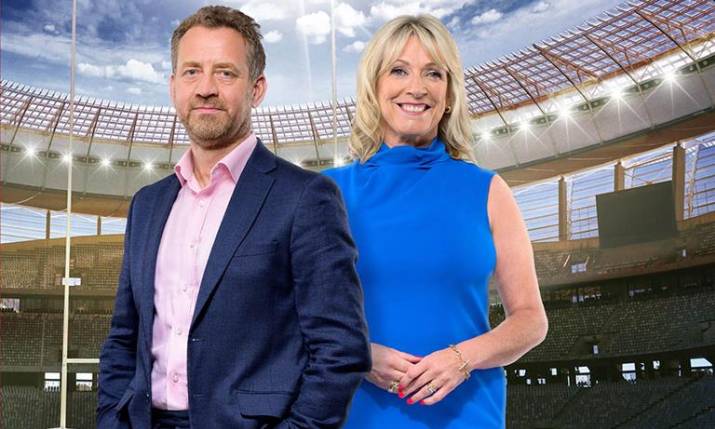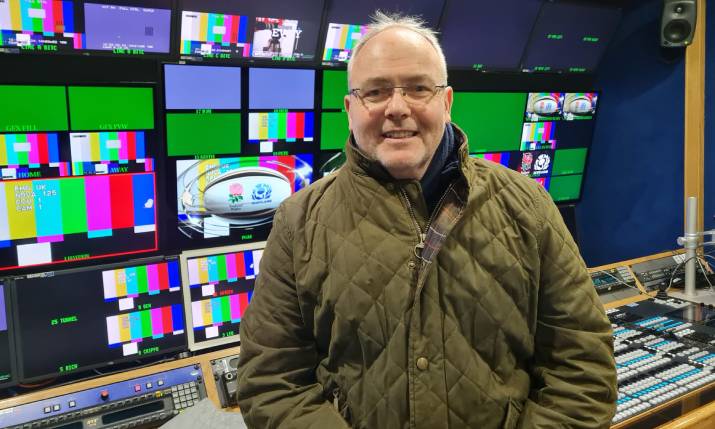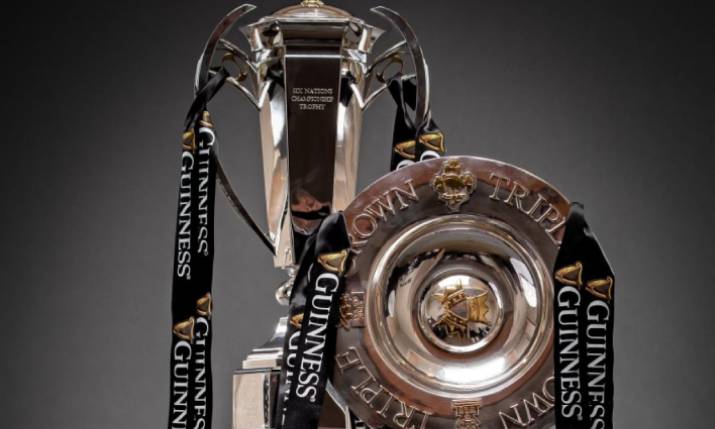Six Nations 2024: ITV Sport powers ahead with on-site broadcast coverage

Mark Pougatch and Jill Douglas lead the line up of on-screen talent for ten live clashes of ITV’s Six Nations 2024 coverage
ITV Sport is placing a greater emphasis on pitch-side presentation for the Guinness Men’s Six Nations 2024, with less matches produced remotely via its virtual reality (VR) Sports Studio. The UK broadcaster is also taking a significant first step this year in deploying limited battery power rather than diesel-generated power at England home matches in Twickenham, for which it is host feed provider.
Six Nations 2024 is the latest in an ongoing deal between ITV and the BBC that sees Six Nations matches shared in the UK between both broadcasters on television and online with ITV’s matches aired on ITV1, ITVX, STV and STV Player. S4C also provides Welsh language options during the tournament. ITV will broadcast ten matches this year, two England home games at Twickenham and eight other fixtures.
France Televisions will act as host broadcaster for the France v Ireland opening match in Marseilles this evening (Friday 2 February), following the established Six Nations collaborative approach, with Sky Italia, BBC Scotland, BBC Wales and RTE providing host world feed from Rome, Edinburgh, Cardiff and Dublin throughout the tournament.

Chief technical officer at ITV Sport, Tony Cahalane, in an EMG truck in the TV compound at Twickenham Stadium just days before the Six Nations 2023 kicked off
Going pitch-side
ITV Sport will be on-site at the stadium for five of its eight away matches, opening with pitch-side presentation for France v Ireland in Marseilles and Italy v England in Rome this weekend. Timeline Television is providing the OB trucks for its away matches, with vehicles driving through France and Italy from the UK earlier this week ahead of tournament kick-off.
“Both of our OBs this weekend have five cameras with multiple positions, and then taking in lots of host match feeds as well, in fact up to 12 host feeds for in depth analysis and tournament colour. Connectivity for the OBs is via BMC in Italy and Globecast in France,” ITV Sport technical director Tony Cahalane told SVG Europe.
“For the Rugby World Cup in October it would have been wholly ‘ungreen’ to do all the group stage matches on-site, so they were done as remotes with smaller numbers of the team travelling, and we moved to an on-site scenario once we got into the knock-out stages. The decision for this Six Nations was to go back on-site a bit more, compared to last year’s approach. But it’s still a mix, with some VR and some on-site. The desire driven by Mark Demuth, controller of sport [at ITV], is to be pitch-side whenever we can, because that’s where we find the atmosphere.”
The other three of ITV Sport’s eight away matches will be presented from its VR Sports Studio, hosted by Timeline TV and Moov in Timeline’s Ealing Broadcast Centre. The VR Studio was launched in February 2023 for the Six Nations tournament.
The virtual set allows enhanced pre-match, half-time and full-time presentation and analysis to take place in Ealing while match action happens elsewhere. Built in Unreal Engine, controlled using Brainstorm and operated by Moov, the set features a physical desk and then multiple virtual stand-up and seated presentation positions featuring live VR screens. Augmented reality (AR) graphics elements can be added, created by Moov, with tracking done using Mo-Sys Star Tracker.
Read more Six Nations 2024: Broadcast coverage to feature innovation in the bunker, on the pitch and online
Cahalane told SVG Europe the studio has been continuously improved since its introduction at last year’s Six Nations. Senior director and executive producer, Paul McNamara, and the ITV Sport team have been working to improve the quality of the VR studio to the point where they believe they are reaching the “nirvana” of realism, and have also done significant work to increase transparency when moving around the large space and between studio levels.
Recalls Cahalane: “For the past year we’ve started to hone the studio in terms of making it look more realistic. Paul McNamara tells a nice story about Mark Pougatch’s mother in law calling him just after a show in the VR studio during Rugby World Cup and saying, ‘I’ve just seen you in Paris’ and he replied ‘no I’m in Ealing.’ She was convinced he was in Paris!
“In an unreal world, in a VR world, we’ve now got shadow tracking to generate shadows behind presenters and guests as they move on the floor; it’s like the nirvana of VR when you start to see those type of high-spec, high quality things. The other area we’ve been looking at is that the set itself has three floors and multiple areas, so how can we transition between those areas to make use of that overall VR studio design to give the impression of being in a very large space?
“We honed that during Rugby World Cup and other sports and we’ve been experimenting around how to do everything we would want to do in a normal studio, with lots of set positions and transitions from position A to position B in a fluid way.”
 Sustainable OB power future
Sustainable OB power future
As with the previous years of the current broadcast rights deal, ITV Sport is the host broadcaster for Six Nations matches played at Twickenham: this year two home England games versus Wales in round two and Ireland in round four. The broadcaster will have around 125 personnel on site, producing a world feed and the ITV unilateral presentation from two separate EMG OB trucks. The host production for Twickenham is on-site in the stadium compound, with ACS again providing specialist cameras and AE Live on-hand for AR graphics.
The set up is similar to last year with a 37 camera approach including six super slomo’s, two high motion cameras, a Spidercam, Batcam plus dressing room and coach cameras; the main difference being the decision not to use goalpost cameras for this year’s Twickenham matches.
The biggest introduction for ITV Sport is the use for the first time of a Film & Television Services twin battery generator at Twickenham rather than diesel generation, in collaboration with the stadium using shore power. Cahalane said while a twin battery approach is well established now for TV drama, large outside broadcasts like Six Nations rugby use massively more power.
“It’s a first for ITV Sport. ITV is universally looking at renewable energy and other cleaner power sources, but as Sport we’re obviously heavy users of power, much more than our drama colleagues. ITV have already done quite a lot with small drama set ups and insert units, but the big users of power are large OBs, which is us.
“In Twickenham we normally have two twin sets, one for the host operation and the other typically for visitors and other add-ons that are not transmission-critical. And so, instead of running a second generator, we started looking at (a) using battery power, and (b) trying to promote the development of things such as battery twin sets suitable for outside broadcast use.
“Film & Television Services, now part of Aggreko, have been developing battery twin set-type packs and want to develop a full battery twin set generator; effectively the same technology that’s in a twin set diesel generator, but with battery packs rather than two generators,” said Cahalane.
“They have an early version, not huge capacity but certainly enough to deal with the second generator requirement at Twickenham and we’ve gone for that. They need the ability to be trickle-charged or charged overnight on a sustained power source should the battery start to run down, basically like a UPS operation.
“We’re able to do that in certain venues [like Twickenham] that have quite a lot of shore power rather than power from a generator. Stadiums nowadays have to become greener and greener, and shore power is increasingly coming from a renewable energy provider.
“We’re doing this for the two Twickenham Six Nations matches, so the unilateral side of the operation for visitors will be off battery which is then sustained by shore power provided by the stadium, in collaboration with ourselves, FTVS and our OB supplier EMG.
“This is the first time we’ve ever done it. There’s no risk really; we’ve been very careful. This is a toe in the water, but the key thing is that it supports development of more and more use for OBs and certainly the development of supplier hardware in order to be able to do increase our use,” he said.
“The more we demand, the more they can produce the money for R&D and get these things off the ground and on the road for us. It’s very much a thought-out roadmap around trying to support and encourage and convince the boards of various suppliers that the R&D development money would be well spent in moving forward resilient, redundant power sources for outside broadcast.”

